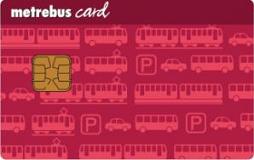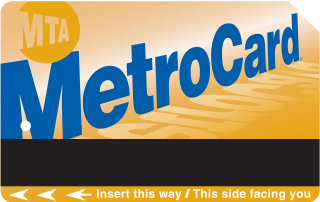
The MetroCard is a magnetic stripe card used for fare payment on transportation in the New York City area. It is a payment method for the New York City Subway, New York City Transit buses and MTA buses. The MetroCard is also accepted by several partner agencies: Nassau Inter-County Express (NICE), the PATH train system, the Roosevelt Island Tramway, AirTrain JFK, and Westchester County's Bee-Line Bus System.
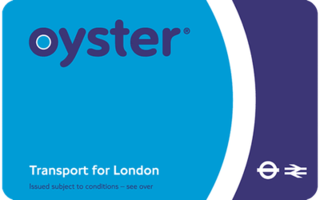
The Oyster card is a payment method for public transport in London in England, United Kingdom. A standard Oyster card is a blue credit-card-sized stored-value contactless smart card. It is promoted by Transport for London (TfL) and can be used on travel modes across London including London Buses, London Underground, the Docklands Light Railway (DLR), London Overground, Tramlink, some river boat services, and most National Rail services within the London fare zones. Since its introduction in June 2003, more than 86 million cards have been used.

Rome–Ciampino International Airport "G. B. Pastine" is the secondary international airport serving Rome, the capital of Italy, after Rome-Fiumicino Airport "Leonardo da Vinci". It is a joint civilian, commercial and military airport situated 6.5 NM south southeast of central Rome, just outside the Greater Ring Road the circular motorway around the city.

SmarTrip is a contactless stored-value smart card payment system managed by the Washington Metropolitan Area Transit Authority (WMATA). The Maryland Transit Administration (MTA) uses a compatible payment system called CharmCard. A reciprocity agreement between the MTA and WMATA allows either card to be used for travel on any of the participating transit systems in the Baltimore-Washington metropolitan area. Unlike traditional paper farecards or bus passes, SmarTrip/CharmCard is designed to be permanent and reloadable; the term "SmarTrip" may refer to both payment systems unless otherwise noted.

The Rome Metro is a rapid transit system that operates in Rome, Italy. It started operation in 1955, making it the oldest in the country.

Storstockholms Lokaltrafik (SL), or more formally Aktiebolaget Storstockholms Lokaltrafik, is the organisation running all of the land based public transport systems in Stockholm County. It was previously known as Stockholms Lokaltrafik.

The Navigo pass is a family of contactless smart cards that can be used for payment in public transportation in Paris and the Île-de-France region. It was first introduced on 1 October 2001. The cards are implemented as contactless smart cards using the Calypso standard, initially with Radio-frequency identification (RFID), then Near-field communication (NFC) since 9 December 2013, and enables authenticated access at turnstiles by scanning the card at an electronic reader. Cards can be loaded with tickets and passes at staffed counters and at ticket vending machines. Since July 2018, they can also be recharged directly using a smartphone. Certain Android smartphones can be used in place of Navigo passes using the Île-de-France Mobilités app, allowing validation at Navigo card readers using NFC functionality.
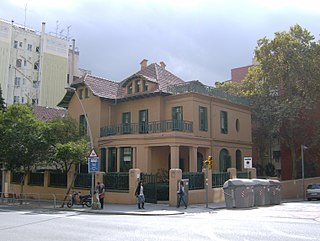
The Metropolitan Transport Authority is a public consortium intended to coordinate the operation and project the expansion of the public transport system in the Barcelona metropolitan area. It is made up of the Government of Catalonia and local administrations. It has been known as ATM Àrea de Barcelona since 2003 to differentiate it from the other existing Catalan public transport authorities in the Girona, Camp de Tarragona and Lleida areas, which are also identified as ATM. As of January 2015, the ATM-managed public transport system comprises 50 different operating companies and serves 346 municipalities, accounting for a population of over 5.7 million.

A transit pass or travel card, often referred to as a bus pass or train pass etc., is a ticket that allows a passenger of the service to take either a certain number of pre-purchased trips or unlimited trips within a fixed period of time.
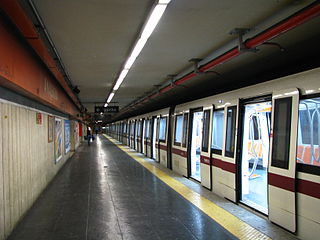
Anagnina is a station of Line A of the Rome Metro. It is located at the junction between Via Tuscolana and Via Anagnina, close to the depot of Osteria del Curato. The station is at an altitude of 53 metres (174 ft) above sea level.

The FL lines, formerly Lazio regional railways consist of 8 commuter rail lines operated by Trenitalia, converging on the city of Rome.
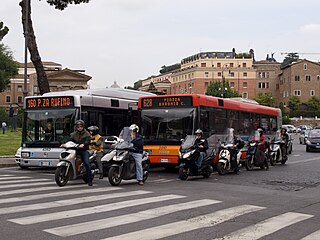
Rome has an extensive internal transport system and is one of the most important road, rail and air hubs in Italy.
GO Transit is the inter-regional transportation authority of the Golden Horseshoe, which includes the Greater Toronto and Hamilton Area. It is Canada's oldest regional transit system, first serving passengers in 1967.
Public transport fares in the Île-de-France are set using a system of concentric fare zones radiating from central Paris, and are implemented with a mixture of paper and electronic tickets. Prices are determined by Île-de-France Mobilités, the regional autorité organisatrice de transports. As of January 2024, single tickets within Paris cost €2.15, and monthly passes covering all fare zones cost €86.40.
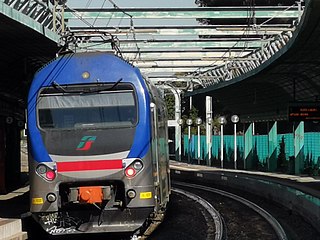
The FL3 is a commuter rail route. It forms part of the network of the Lazio regional railways, which is operated by Trenitalia, and converges on the city of Rome, Italy.

MetroCARD is a contactless smartcard ticketing system for public transport services in the Adelaide city and suburbs in South Australia. The system is managed by Adelaide Metro and is usable on their bus, train and tram services.

ATAC S.p.A. is an Italian publicly owned company running most of the local public transportation services, paid parking and incentive parking lots in Rome. More specifically, the company handles, on behalf of Roma Capitale Authority, the entire tramway, trolleybus network and metro lines, as well as most of the bus lines in the city. It also operates, on behalf of the Administrative Region of Lazio, three railways: Roma-Civita Castellana-Viterbo, Roma-Giardinetti and Roma-Lido. ATAC S.p.A., with its 2,200-kilometer-wide public transport network, its over 8,500 busses and 70,000 parking stalls, is currently one of the biggest public transportation companies in Europe and the largest in Italy.

The Troika card is a contactless reusable card designed to pay for public transport in Moscow. It is the centrepiece of the new ticketing menu introduced in Moscow on April 2, 2013.

Cotral SpA is a limited company which runs suburban and inter-urban public transport services in the Lazio region of Italy.
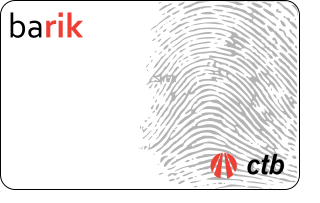
Barik is a rechargeable contactless smart card, electronic money used for public transport in Biscay (Spain).
